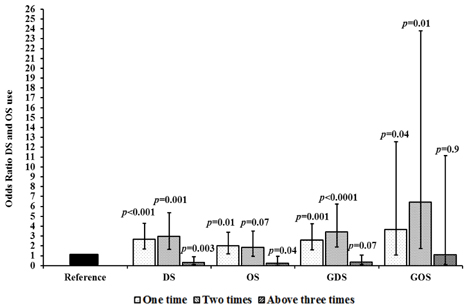Nutr Res Pract.
2011 Aug;5(4):349-356.
Anti-doping education and dietary supplementation practice in Korean elite university athletes
- Affiliations
-
- 1Sports Science Institute, Korea National Sport University, 88-15 Oryun-dong, Songpa-gu, Seoul 138-763, Korea. namju73@hotmail.com
- 2Department of Physical Education, College of Physical Education, Kyonggi University, Suwon 443-760, Korea.
Abstract
- This study was conducted to investigate relationships and gender differences in dietary supplement (DS) and oriental supplement (OS) prevalence as well as anti-doping awareness during training and the game period. Korea National Sport University athletes (343 male and 136 female) participated in this study and completed DS and OS practice and anti-doping awareness questionnaires. Forty-six percent of athletes used DS during the training period, and there was significantly higher DS use in females (53%) compared to males (43%) (P < 0.05). Twenty-eight percent of athletes used OS, and there was significantly higher OS use in females (35%) than males (26%) (P < 0.05) during the training period. The primary reason of DS use was to supply energy both in males (36%) and females (28%). The main reason for male athletes' OS use was to supply energy (41%). Meanwhile, the reasons for female athletes' OS use were to supply energy (23%), to maintain health (19%), and to improve recovery ability (20%), which showed a significant gender difference (P < 0.05). Athletes rated their perceived degree of satisfaction, perceived importance, and beliefs in efficacy of DS and OS use all over 50% during the training period, and no gender differences were detected. In a comparison between athletes educated about anti-doping (at least more than one time) and non-received athletes, DS and OS use during the training period was 2.30 (1.47-3.60) and 1.71 (1.03-2.82), respectively. DS and OS use immediately before the game period was 2.38 (1.50-3.80) and 3.99 (1.20-13.28), respectively. Elite athletes' anti-doping education was highly related to increased DS use during the training period and immediately before the game. Although elite athletes use various DS and OS during the training period and before the game period, doping education for elite athletes is related with DS and OS use during the training period and before the game.
MeSH Terms
Figure
Reference
-
1. Corrigan B, Kazlauskas R. Medication use in athletes selected for doping control at the Sydney Olympics (2000). Clin J Sport Med. 2003. 13:33–40.
Article2. Huang SH, Johnson K, Pipe AL. The use of dietary supplements and medications by Canadian athletes at the Atlanta and Sydney Olympic Games. Clin J Sport Med. 2006. 16:27–33.
Article3. Ronsen O, Sundgot-Borgen J, Maehlum S. Supplement use and nutritional habits in Norwegian elite athletes. Scand J Med Sci Sports. 1999. 9:28–35.
Article4. Sundgot-Borgen J, Berglund B, Torstveit MK. Nutritional supplements in Norwegian elite athletes--impact of international ranking and advisors. Scand J Med Sci Sports. 2003. 13:138–144.
Article5. Tsitsimpikou C, Tsiokanos A, Tsarouhas K, Schamasch P, Fitch KD, Valasiadis D, Jamurtas A. Medication use by athletes at the Athens 2004 Summer Olympic Games. Clin J Sport Med. 2009. 19:33–38.
Article6. Erdman KA, Fung TS, Reimer RA. Influence of performance level on dietary supplementation in elite Canadian athletes. Med Sci Sports Exerc. 2006. 38:349–356.
Article7. Kim J, Kang SK, Jung HS, Chun YS, Trilk J, Jung SH. Dietary supplementation patterns of Korean Olympic Athletes participating in the Beijing 2008 Summer Olympic Games. Int J Sport Nutr Exerc Metab. 2011. 21:166–174.
Article8. Kim J, Chun YS, Kang SK, Cho HC. The use of herbal/traditional products supplementation and doping tests in elite athletes. Int J Appl Sports Sci. 2010. 22:137–149.
Article9. Kim J, Kang SK, Chun YS, Jung SH. Association between anti-doping awareness and dietary supplement use in Korean elite junior athletes. Korean J Exer Nutr. 2010. 14:175–181.10. Ock SM, Hwang SS, Lee JS, Song CH, Ock CM. Dietary supplement use by South Korean adults: Data from the national complementary and alternative medicine use survey (NCAMUS) in 2006. Nutr Res Pract. 2010. 4:69–74.
Article11. Chun YS, Kang SK, Lee KI, Kim JK. The use of nutrition ergogenic aids and doping awareness by anti-doping education in Korean internaltional team athletes. Korean J Phys Educ. 2010. 49:437–445.12. Kim SH, Keen CL. Patterns of vitamin/mineral supplement usage by adolescents attending athletic high schools in Korea. Int J Sport Nutr. 1999. 9:391–405.
Article13. Kim JY, Pham DD. Understanding oriental medicine using a systems approach. Evid Based Complement Alternat Med. 2009. [Epub ahead of print].
Article14. Wiseman N. Designations of medicines. Evid Based Complement Alternat Med. 2004. 1:327–329.
Article15. Wewers ME, Lowe NK. A critical review of visual analogue scales in the measurement of clinical phenomena. Res Nurs Health. 1990. 13:227–236.
Article16. Nevill AM, Lane AM, Kilgour LJ, Bowes N, Whyte GP. Stability of psychometric questionnaires. J Sports Sci. 2001. 19:273–278.
Article17. Slater G, Tan B, Teh KC. Dietary supplementation practices of Singaporean athletes. Int J Sport Nutr Exerc Metab. 2003. 13:320–332.
Article18. Tian HH, Ong WS, Tan CL. Nutritional supplement use among university athletes in Singapore. Singapore Med J. 2009. 50:165–172.19. Cochran WG. Sampling techniques. 1977. 3rd ed. New York: Wiley.20. William JH, William GH. A review of response surface methodology: a literature survey. Technometrics. 1966. 8:571–590.
Article21. Erdman KA, Fung TS, Doyle-Baker PK, Verhoef MJ, Reimer RA. Dietary supplementation of high-performance Canadian athletes by age and gender. Clin J Sport Med. 2007. 17:458–464.
Article22. Williams MH. Dietary supplements and sports performance: introduction and vitamins. J Int Soc Sports Nutr. 2004. 1:1–6.
Article
- Full Text Links
- Actions
-
Cited
- CITED
-
- Close
- Share
- Similar articles
-
- Attitudes and Dispositions toward Doping in Adolescent Elite Athletes
- Characteristics of E-sports and the Role of Pharmacist in Doping
- Attitudes and Dispositions about Doping of the Korean National Team Who Participated in the Incheon Asian Para Games
- Anti-doping Policy Development Process in the Sports World (1968~1999): Focusing on IOC Activities and Passive Response from Korea
- Analysis of the Relationship between Athletes’ Attitudes toward Doping, Sport Orientation, and Perceived Motivational Climate in Sport among Collegiate Athletes



